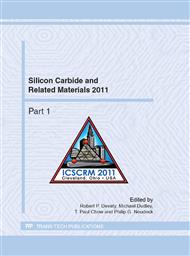p.21
p.25
p.29
p.33
p.37
p.41
p.45
p.49
p.53
Synthesis and Purification of Silicon Carbide Powders for Crystal Growth
Abstract:
Silicon carbide powders were prepared in a vacuum induction melting furnace (VIM). Silica and silicon were used as sources of silicon, and graphite powder was used a source of carbon. Pressures of 0.1 and 0.01 atm were selected as the operation conditions, and different silicon carbide powders were prepared. Free carbon and remnant silica were removed by high-temperature baking in air and acid leaching. Low-pressure powders show better crystallinity; moreover, free carbon and silica were rarely found in the product after baking and leaching. The low-pressure grains were prismatic whereas the high-pressure grains were porous. This shows that pressure is a critical parameter in silicon carbide formation, and low-pressure makes the low-temperature synthesis of silicon carbide feasible. Glow discharge mass spectra were used to analyze the impurity content in silicon carbide powders. After baking and leaching, the purity is increased from 3N5 (99.95 wt.%) to 4N5 (99.995 wt.%). Further purification procedures will be combined to meet the quality requirements for crystal growth.
Info:
Periodical:
Pages:
37-40
Citation:
Online since:
May 2012
Authors:
Keywords:
Price:
Сopyright:
© 2012 Trans Tech Publications Ltd. All Rights Reserved
Share:
Citation:


